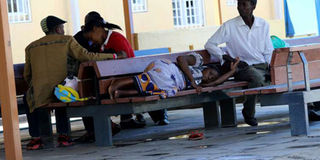20 patients died in August strike: report

Patients are seen waiting on benches at the casualty area of the Provincial General Hospital in Nakuru on August 12, 2015 as health workers went on strike. Twenty patients died in August during a health workers’ strike in Nakuru, a report has revealed. PHOTO | SULEIMAN MBATIAH | NATION MEDIA GROUP
What you need to know:
- It also emerged that there was a major drug shortage in public health facilities during the strike due to a more than Sh94.4 million-debt owed to the Kenya Medical Supplies Agency (KEMSA).
- This facts were contained in a detailed report that was presented before the County Assembly which also proved negligence in the way the county government handled the industrial action.
- According to the report prepared by the County Executive Committee Member for Health Dr Kabii Mungai and his Chief Officer Dr Samuel Mwaura, 14 people died at the Rift Valley Provincial General hospital, five at the Naivasha Level 4 hospital and another one at Elburgon Hospital bringing the number to 20.
Twenty patients died in August during a health workers’ strike in Nakuru, a report has revealed.
This is contrary to earlier reports that had indicated only 11 patients had died during the strike.
It also emerged that there was a major drug shortage in public health facilities during the strike due to a more than Sh94.4 million-debt owed to the Kenya Medical Supplies Agency (KEMSA).
This facts were contained in a detailed report that was presented before the County Assembly which also proved negligence in the way the county government handled the industrial action.
According to the report prepared by the County Executive Committee Member for Health Dr Kabii Mungai and his Chief Officer Dr Samuel Mwaura, 14 people died at the Rift Valley Provincial General hospital, five at the Naivasha Level 4 hospital and another one at Elburgon Hospital bringing the number to 20.
Earlier reports in the media quoting Nakuru Deputy Governor Mr Joseph Ruto had indicated that only 11 people died at the public facilities due to lack of treatment.
The report had been sought by Subukia County Representative Mr Joseph Waithaka who demanded to know the cause of the trike, the patients who died at public health facilities during the strike.
Mr Waithaka also sought answers on how the County Executive Committee Member for Health handled the strike and what the county government and the health management was doing to avert future strikes.
Dr Mungai said the county government had formed a Human Advisory Committee under the department of human resource to be dealing with promotions, appraisals, performance and discipline to avert strikes.
He said the health departments had also made sure that health workers were paid in good time pending a meeting with the Salaries and Remuneration Commission and the County Public Service Board to discuss harmonisation.
“The county will also be giving incentives to the hardworking health workers through a quarterly customer satisfactory survey,” read part of the report.
Dr Mungai said he could not comment on the strike when it was going on since the Deputy Governor had issued statements which were aired by different media houses.
He also denied claims that he was away on trip saying that he cancelled his travel to the United States of America due to the strike and the status of pharmaceutical and non-pharmaceutical supply in the county.
He said the county was suffering a shortage of medical supplies due to the Sh94.4 million-debt owed to KEMSA.





